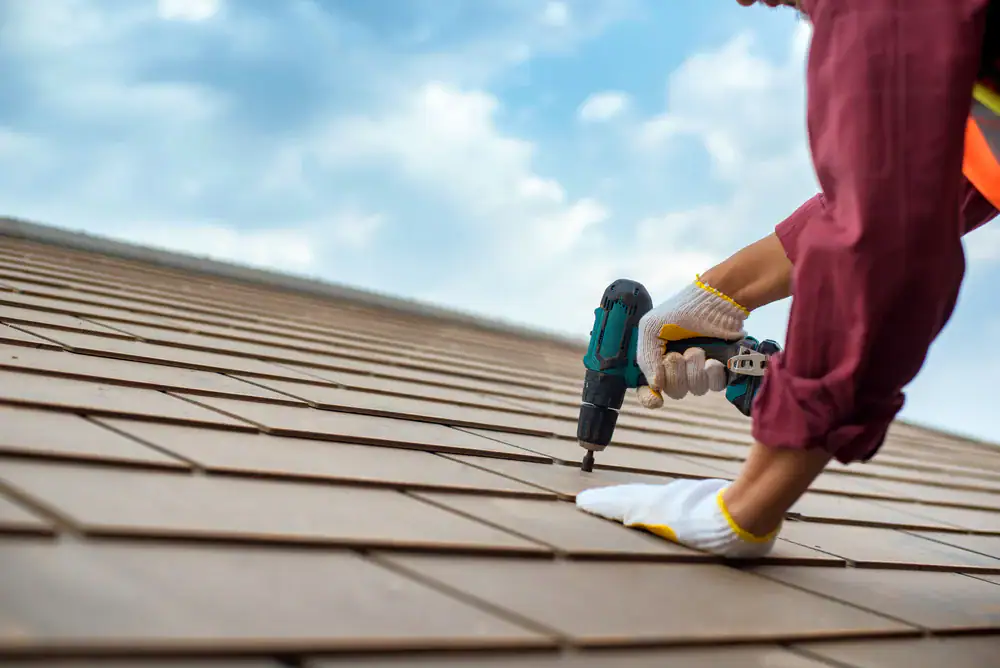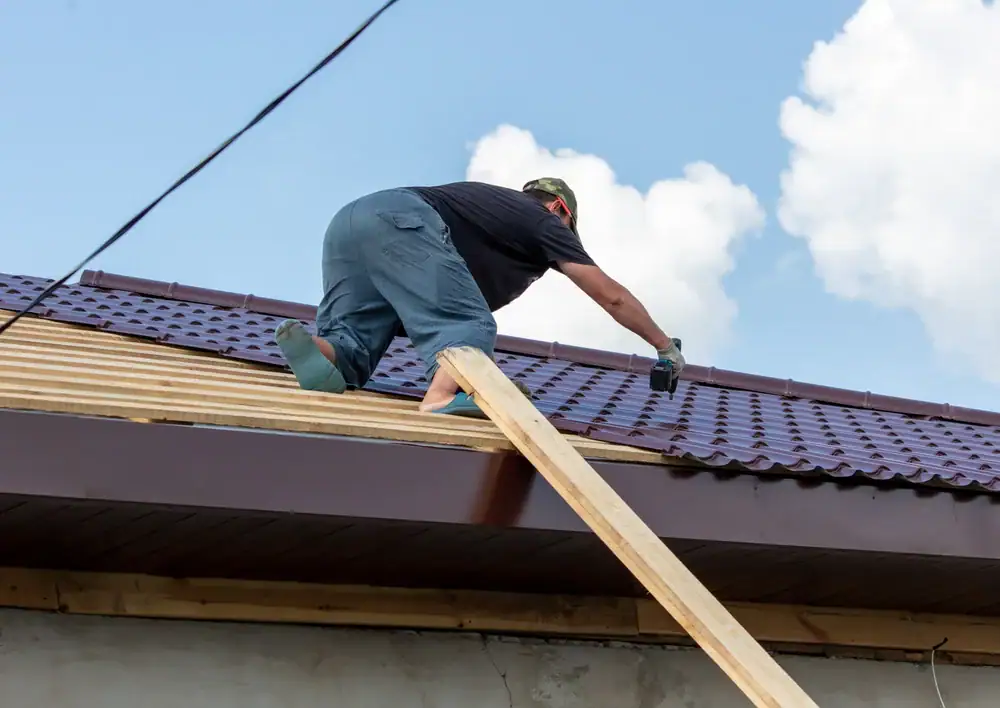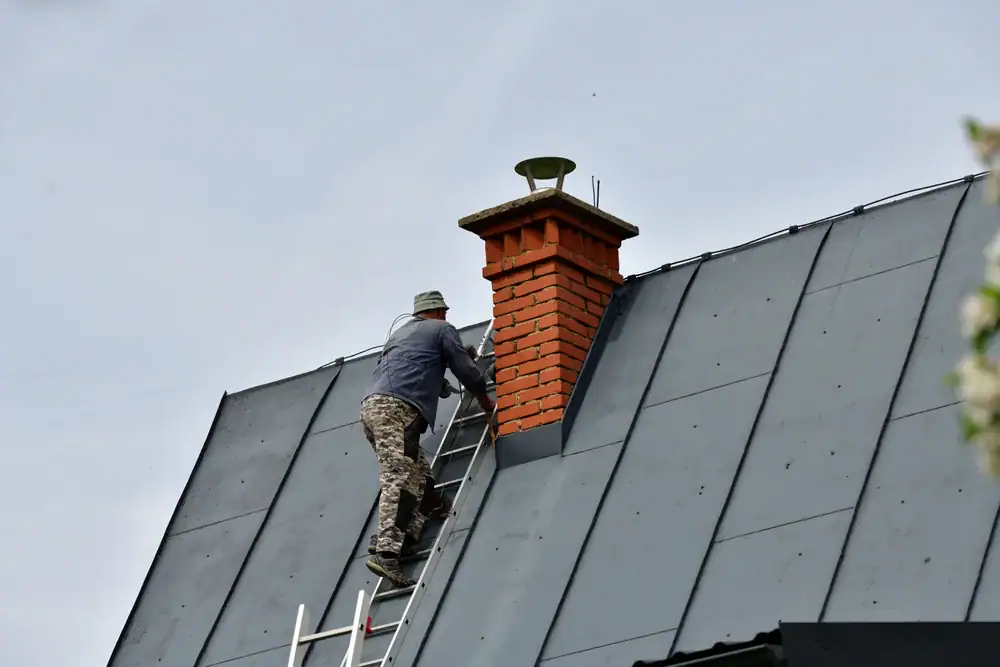Heavy rain roof leak? Learn the critical first steps Suffolk County homeowners must take to protect their homes and prevent costly damage.
Share:

Summary:
The moment you discover water coming through your ceiling, your priority shifts to safety and damage control. Water and electricity create dangerous situations that can turn a roof leak into a life-threatening emergency.
First, check if water is near any electrical outlets, fixtures, or appliances. If you see water around electrical components, shut off power to that area immediately at your circuit breaker. Never touch electrical switches or outlets with wet hands.
Clear the area of people and pets, then start protecting your belongings and floors from further water damage.

Once you’ve addressed safety concerns, focus on containing the water to prevent it from spreading throughout your home. Speed matters here because water damage can begin within hours, and mold can start growing in just 24-48 hours.
Place large containers directly under the leak to catch dripping water. Garbage bins with wheels work best for heavy leaks since you can move and empty them easily. If water is pooling in your ceiling and creating a bulge, carefully make a small hole in the center with a screwdriver to create one controlled stream rather than letting water spread across a larger area.
Move furniture, electronics, and valuables away from the affected area. For heavy items you can’t relocate, cover them with waterproof tarps or plastic sheeting. Create clear pathways so everyone can move safely through the room without slipping on wet surfaces.
Use towels to soak up standing water on floors immediately. This prevents water from seeping into flooring materials and reduces slip hazards. Keep replacing saturated towels with dry ones, and wring them out into your containers or bathtub.
Set up fans if you can do so safely to help air circulation and prevent moisture from settling into walls and furniture. The faster you can dry wet areas, the better your chances of preventing permanent damage and mold growth.
Understanding where water is actually entering your roof helps you communicate effectively with emergency repair services and can guide temporary fixes if conditions allow. However, remember that water rarely drips straight down from its entry point.
Water typically travels along beams, rafters, or pipes before it finally drips through your ceiling. This means the visible leak in your living room might actually be entering your roof several feet away. Don’t assume the source is directly above where you see water.
If it’s safe to access your attic, grab a flashlight and look for signs of water entry from underneath your roof decking. You might see active dripping, wet spots, or dark stains on the wood that indicate where moisture has been entering. Even if you can’t see active water flow, darkened areas on roof decking usually mark leak locations.
Look for obvious culprits like damaged or missing shingles, problems around chimneys or vents, or issues with flashing where your roof meets walls. These are the most common leak sources during heavy rain, especially when wind drives water horizontally into cracks that might not be exposed during lighter rainfall.
If you can safely identify the general area of water entry, place a bucket in your attic to catch water there as well. This prevents water from traveling further through your home’s structure and causing additional damage to insulation and interior walls.
Document what you find with photos if possible. This information helps roofing professionals diagnose the problem quickly when they arrive, potentially saving you time and money on repairs.
Want live answers?
Connect with a Home Team Construction expert for fast, friendly support.
Some roof leaks require immediate professional intervention, while others can wait until after the storm passes. Understanding the difference helps you make the right call for your situation and safety.
Contact emergency roofing services immediately if water is actively pouring into your home, creating large pools, or if you notice any structural damage like sagging ceilings or walls. These situations indicate serious breaches that could worsen rapidly.
Never attempt roof repairs during active storms or on wet surfaces. Professional emergency services have the proper equipment and training to work safely in dangerous conditions.

Certain leak scenarios create immediate dangers that require professional emergency services, regardless of the time of day or weather conditions. Recognizing these situations can prevent minor problems from becoming major disasters.
Call immediately if water is near electrical wiring, outlets, or your fuse box. This creates serious fire and electrocution risks that only qualified professionals should handle. Similarly, if you notice any signs of structural damage like sagging roof areas, ceiling bulges that seem unstable, or visible holes in your roof, evacuate the area and call for help.
Large volumes of water entering your home also warrant emergency calls. If you’re dealing with more water than containers can handle, or if multiple areas of your home are affected, professional intervention can prevent the situation from overwhelming your home’s structure.
Weather forecasts play a crucial role in your decision. If more severe weather is approaching and your temporary fixes might not hold, getting professional help before conditions worsen protects your home more effectively than waiting until after the next storm.
Don’t hesitate to call if you’re unsure about electrical safety, structural integrity, or your ability to manage the water volume. Emergency roofing services would rather respond to a situation that turns out manageable than arrive too late to prevent serious damage.
Professional roofers also have specialized equipment like industrial tarps, emergency sealants, and safety gear that allow them to create more effective temporary repairs than typical homeowner solutions.
If conditions allow and the leak isn’t creating immediate safety hazards, certain temporary measures can help minimize damage until professional repairs are possible. However, never attempt these fixes during active storms or on wet, slippery surfaces.
From inside your attic, you might be able to apply roofing cement or tar to small leak areas if you can safely access them. Use a piece of plywood or spare shingle pressed against the roofing tar to create a temporary barrier. This approach works best for pinpoint leaks rather than large damaged areas.
For larger exterior damage visible from the ground, heavy-duty tarps can provide temporary protection. If you can safely access your roof after the storm passes, spread the tarp over the damaged area, extending it at least four feet beyond the problem zone. Secure it with roofing nails or heavy weights, ensuring one edge extends over your roof’s peak to prevent water from running underneath.
Interior temporary fixes focus on water management rather than stopping the leak itself. You can create water diversion systems using hoses or tubing to direct ceiling leaks into bathtubs or large containers, reducing floor damage and making cleanup easier.
Remember that all temporary fixes are exactly that—temporary. Even the best DIY solutions typically last only days or weeks at most. Plan to have professional repairs completed as soon as weather and contractor availability allow.
Document your temporary repairs with photos for insurance purposes and to help professional roofers understand what you’ve already attempted when they arrive for permanent repairs.
Quick action during roof emergencies can save thousands in water damage and protect your family’s safety. The steps you take in those first critical moments—ensuring electrical safety, containing water, and identifying serious hazards—make the difference between manageable repairs and major home restoration projects.
Suffolk County’s challenging weather patterns mean roof emergencies will continue to test homes throughout our area. Regular roof inspections, prompt attention to minor issues, and knowing exactly what to do when leaks occur gives you the best protection against storm damage.
When you need emergency roofing services or want to prevent future problems, we at Home Team Construction understand the unique challenges Suffolk County homeowners face and provide the reliable, professional response your home deserves.
Article details:
Share: